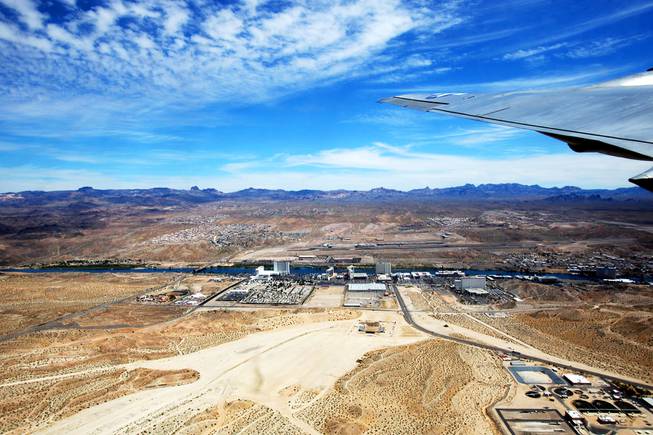
Justin Bowen
Laughlin and Bullhead City, Ariz., as seen in 2011.
Tuesday, Dec. 20, 2011 | 2 a.m.
Sun archives
- Big plans for Laughlin solar plant are bogged down (11-13-2011)
- County to consider sale of 9,000 acres to Chinese energy company (9-20-2011)
- Chinese energy company seeks more county land for ‘eco-city’ (9-19-2011)
- $6 billion news escapes some Laughlin residents, but not for long (7-6-2011)
- County backs proposed solar energy farm near Laughlin (7-5-2011)
- Solar project could be start of diversified economy (6-30-11)
- Deadlines may shelve renewable energy projects (6-25-2011)
The sale of 9,000 acres of county land near Laughlin, which is likely to be approved by the Clark County Commission today, represents a small step toward development of a massive solar power complex by its Chinese backers.
The county’s asking price for the land — $4.5 million — is far below two appraisals that put its value at between $29.6 million and $38.6 million. But Commissioner Steve Sisolak, whose district includes Laughlin, said the price is justifiable given the economic impact the project will have on Southern Nevada.
“Public bodies do this all the time in the name of jobs,” he said. “Some even give away land to encourage development. We think this will be huge for Nevada.”
ENN Mojave Energy LLC, the Chinese company behind the project, announced in June its intentions to first build a solar panel factory, then a massive solar energy plant on land near the southern tip of the state.
The company ultimately wants to build an “eco-city” — powered by renewable energy generation with solar energy manufacturing as the primary source of employment for its residents.
Armed with financing for the project, the company seeks over the next 13 years to increase output from 280 megawatts to 840 megawatts (enough to supply about 200,000 homes) and a $1 billion price tag to $6 billion.
Company estimates put the number of construction jobs associated with the project at 462, and as it progresses, that number could grow to 2,944 by the end of 2015; permanent jobs during the first five years would number between 590 and 2,222.
Perceptions of the plant’s potential economic impact on Laughlin and Southern Nevada is highlighted by the fact that sources say U.S. Sen. Harry Reid, who visited ENN’s plant in China this year, is using his influence to work out power-purchase agreements between ENN and publicly traded or government-operated utilities.
Even with the most powerful man in the U.S. Senate in your corner, nothing is assured. One massive hurdle remains: finding customers for the solar power.
Officials and others close to the project say the project won’t begin for another 12 to 18 months because the energy plant needs to find power purchasers first.
Obtaining agreements to buy the energy — sources say those companies could be in Arizona, Nevada or California — is a time-consuming, exacting endeavor.
One example of possible pitfalls occurred in recent years in California. The state’s thirst for renewable energy may be the largest in the country, as a law was passed this year for companies to increase their renewable energy holdings to 33 percent by 2020.
But complaints about the cost of renewable energy have grown. California’s Public Utilities Commission rejected a Canadian plan to produce ocean energy in part because its high cost would raise power bills. In May, the commission issued a draft resolution rejecting an agreement that would have allowed North Star Solar LLC to build a photovoltaic plant for the same reason. After the company cut expenses by about 20 percent, the plans were approved in October.
Other hurdles include whether the project is considered an “in-state resource.” Out-of-state resources can contribute only a certain percentage of California’s renewable portfolio. That requirement is behind a Pahrump utility’s efforts to leave Nevada’s power grid for California’s to boost solar development in the area.
What could help ENN in this regard would be a link to California’s grid in the Eldorado Valley, near Boulder City, a so-called “first point of interconnection.” That would be expensive if the company must build its own transmission line reaching the roughly 80 miles from Laughlin to Boulder City.
California Gov. Jerry Brown said this year that he wants his state to become an energy exporter instead of an importer. That’s not to say ENN would be out of the running.
“I understand there are policy goals that we hear out of the Legislature,” said Mignon Marks, executive director of the California Solar Energy Industries Association. “But there is a certain amount of obligation that can be met with out-of-state sources, even the sale of renewable energy credits.”
The County Commission meeting begins at 9:15 a.m. today.

Join the Discussion:
Check this out for a full explanation of our conversion to the LiveFyre commenting system and instructions on how to sign up for an account.
Full comments policy